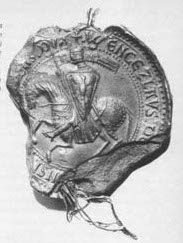Wenceslaus I of Bohemia
| Wenceslaus I | |
|---|---|

Seal of Wenceslaus I
|
|
| King of Bohemia | |
| Reign | 1230–1253 |
| Predecessor | Ottokar I |
| Successor | Ottokar II |
| Born | c. 1205 Kingdom of Bohemia |
| Died | 23 September 1253 (aged c. 48) Králův Dvůr, Kingdom of Bohemia |
| Spouse | Kunigunde of Swabia |
| Issue more... |
Vladislaus, Margrave of Moravia Ottokar II, King of Bohemia Beatrice, Margravine of Brandenburg |
| House | Přemyslid dynasty |
| Father | Ottokar I of Bohemia |
| Mother | Constance of Hungary |
Wenceslaus I (Czech: Václav I. Přemyslid; c. 1205 – 23 September 1253), called One-Eyed, was King of Bohemia from 1230 to 1253.
Wenceslaus was a son of Ottokar I of Bohemia and his second wife Constance of Hungary.
In 1224, Wenceslaus married Kunigunde of Hohenstaufen, third daughter of Philip of Swabia, King of Germany, and his wife Irene Angelina. Wenceslaus encouraged large numbers of Germans to settle in the villages and towns in Bohemia and Moravia. Stone buildings began to replace wooden ones in Prague as a result of the influence of the new settlers.
Wenceslaus and Kunigunde had five known children:
On 6 February 1228, Wenceslaus was crowned as co-ruler of the Kingdom of Bohemia with his father. On 15 December 1230, Ottokar died and Wenceslaus succeeded him as the senior King of Bohemia.
His early reign was preoccupied by the threat to Bohemia posed by Frederick II, Duke of Austria. The expansionism of Frederick caused the concern and protestation of several other rulers. In 1236, Holy Roman Emperor Frederick II was involved in a war against the Lombard League. The Emperor demanded Wenceslaus and other rulers of the Holy Roman Empire to lend him part of their own troops for his war effort. Wenceslaus led a group of princes who expressed their reluctance to divert any troops from the defense of their own territories, citing fear of invasion from the Duchy of Austria. They requested imperial intervention in the situation.
In June 1236, the Emperor imposed an imperial ban on the Duke of Austria. Troops dispatched against the Duke forced him to flee Vienna for Wiener Neustadt. He would continue to rule a rump state for the following year. The Emperor declared direct imperial rule in both Austria and the Duchy of Styria, also held by the fleeing Duke. Ekbert von Andechs-Meranien, former Bishop of Bamberg was installed as governor in the two Duchies. Ekbert would govern from February to his death on 5 June 1237. Wenceslaus was hardly pleased with this apparent expansion of direct imperial authority close to his borders. Wenceslaus and Duke Frederick formed an alliance against the Emperor. Frederick the Emperor chose to lift the ban in 1237 rather than maintain another open front. Wenceslaus managed to negotiate the expansion of Bohemia north of the Danube, annexing territories offered by Duke Frederick in order of forming and maintaining their alliance.
...
Wikipedia
